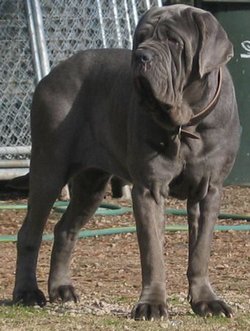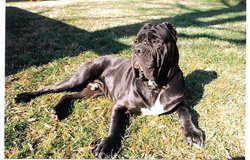Neapolitan Mastiff
Dogs
Neapolitan Mastiff
| Neapolitan Mastiff |

Female Mastino
|
| Alternative names |
Mastino Napoletano
Mastino
Italian Mastiff |
| Country of origin |
|
Italy |
| Common nicknames |
| Neo |
| Classification and breed standards |
|
FCI: |
Group 2 Section 2 #197 |
|
|
AKC: |
Working |
|
|
ANKC: |
Group 6 (Utility) |
|
|
CKC: |
Miscellaneous |
|
|
KC (UK): |
Working |
|
|
NZKC: |
Utility |
|
|
UKC: |
Guardian |
|
| Not recognized by any major kennel club |
| This breed of dog is
extinct |
| Notes |
| |
The Neapolitan Mastiff is a large, ancient
breed of
dog that can be
traced back to about
100 BC. This
dog is a massive, awe-inspiring dog breed often used as a
guard and
defender of owner and property.
Appearance
Neapolitan Mastiffs are characterized by loose skin over their entire bodies;
abundant, hanging wrinkles and folds on the head; and a voluminous
dewlap. Coats
can be blue, grey, black, brindle, or chocolate, sometimes with white on the
chest or feet. Ears usually are half pricked and can be cropped. It has a large
blocky head and a rolling gait.
Temperment
The Neapolitan Mastiff is a fearless protector when it needs to be but is
affectionate with its family and the family's friends; as a guarding breed it is
quite wary around strangers but it will relax once it gets to know the person in
question. It does not bark excessively and indeed only barks when something
provokes it. As a breed the Neapolitan Mastiff can be stubborn, but it does not
require repetitious training--once it understands what its master wants, it will
obey. It has a dominant attitude and must be taught from puppyhood that its
master is the boss, not the other way around. Males can be much more aggressive
and dominant than females. A female works best in a home with a family, as she
is a bit more docile and better with children. These dogs are, however, usually
very loving with children, provided they do not tease them. Males do not get
along with other males, but the Neopolitan can get along well with non-canine
pets if raised with them from puppyhood.
The Neapolitan Mastiff is not a breed for everyone and not a dog for
beginners. Children should be taught to respect these dogs. Neapolitan Mastiffs
should be well socialized at an early age to avoid over-protectiveness. They
will be quite protective even with extensive socialization. Additional
protection training is unnecessary because they are naturally guard dogs and
have been for ages. Obedience training is very important in this breed. The Neo
is generally very tolerant of pain due to the breed's early fighting background.
Males often drool quite heavily. They tend to drool more in hot weather or after
drinking water.
History
The Neapolitan Mastiff is descendant of the
Molossus, the mammoth war dogs of the
Middle
East, and was frequently used in the Roman
arenas pitted
against lions,
bears, and
gladiators
for entertainment. As dogs of war, they fought alongside the Roman
legions, and in
this way they were spread throughout
Europe.
Eventually the descendants of the Roman Molossian splintered into several
different Mastiff breeds:
English Mastiff,
Dogue de Bordeaux,
Spanish Mastiff,
St. Bernard, and
Rottweiler.
In the 1940s,
this breed was rediscovered near
Naples in
Italy, and is now
beginning to make a comeback. A Neapolitan Mastiff was featured in the
Harry
Potter movies as Hagrid's dog Fang.
 Male Neapolitan Mastiff
Male Neapolitan Mastiff
Famous Mastiffs
- Alan from
Babe: Pig In The City
- Fang from
Harry Potter
References
Home | Up | Neapolitan Mastiff | New Guinea Singing Dog | Newfoundland | Norrbottenspets | Norfolk Terrier | Norwegian Buhund | Norwegian Elkhound | Norwegian Lundehund | Norwich Terrier | Nova Scotia Duck - Tolling Retriever
Dogs, made by MultiMedia | Free content and software
This guide is licensed under the GNU
Free Documentation License. It uses material from the Wikipedia.
|




